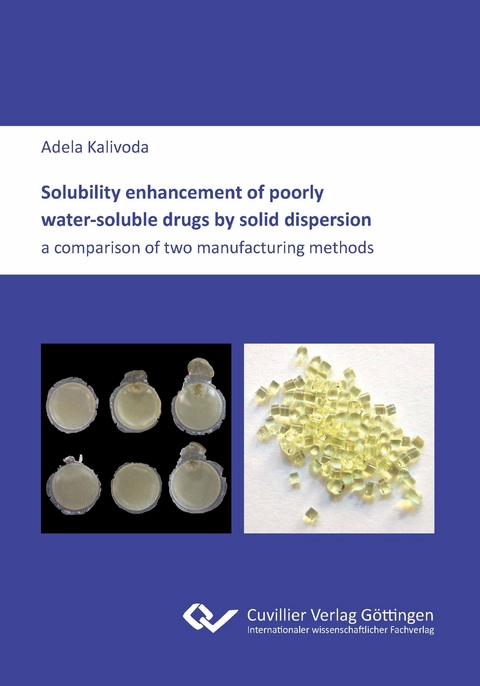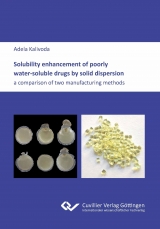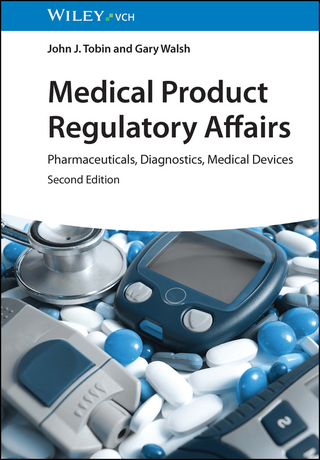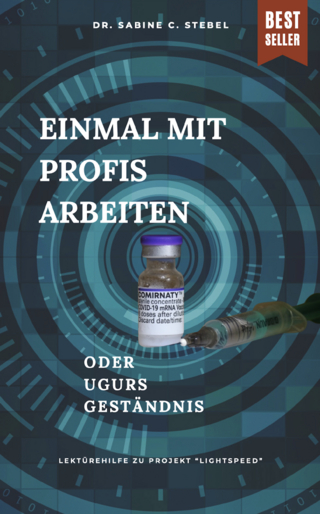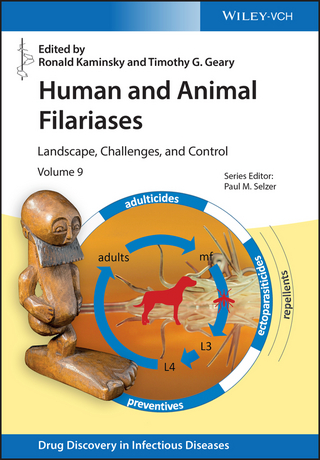Solubility enhancement of poorly water-soluble drugs by solid dispersion
a comparison of two manufacturing methods
Seiten
2012
|
1., Aufl.
Cuvillier, E (Verlag)
978-3-95404-141-1 (ISBN)
Cuvillier, E (Verlag)
978-3-95404-141-1 (ISBN)
- Titel ist leider vergriffen;
keine Neuauflage - Artikel merken
Solid dispersions are a promising approach for controlled release drug delivery systems as both the bioavailability enhancement of poorly water-soluble drugs as well as the sustained release of water-soluble drugs are possible to optimize their in vivo performance.
Different methods for the manufacture of solid dispersion systems have been introduced in literature. In the present work, two methods are compared: hot-melt extrusion and ultrasound-assisted compaction technique. Various carrier systems and drugs with different physicochemical properties are applied to investigate the feasibility of the technologies for pharmaceutical formulation. The formulations are compared to the corresponding untreated physical blends of the components regarding their solid state structure and dissolution behavior to assess the effect of the manufacturing technique.
Ultrasound-assisted compaction technique improves the initial dissolution rate of fenofibrate, a poorly water-soluble model drug. The crystalline API is partially converted into its amorphous state. As equivalent results can be achieved if the polymers are added directly to the dissolution medium, the dissolution enhancement is attributed to an improved wettability of the drug.
A statistical design of experiments is employed to investigate the effect of the process parameters on the results. Difficulties are encountered in the determination of process parameters which result in an optimal outcome. The process is very sensitive to the smallest changes of settings, for example of the position of the sonotrode. Additionally, the delivery of ultrasound energy is inhomogeneous. There is no or only insufficient user control of these parameters available. Furthermore, the duration of ultrasound energy delivery which is identified as a crucial parameter cannot be set by the user. The variable factors ultrasound energy, pressure of the lower piston and pressure of the upper piston affect the defined responses in the opposite direction. Hence, there are no settings which result in a satisfactory outcome. A strong influence of the material characteristics on the process is observed leading to a batch to batch variability.
Due to an insufficient reproducibility of results, the application of the technology cannot be recommended in its current state in the pharmaceutical formulation development and/or production. Improvements in homogeneity of energy delivery, process monitoring, user control and amount of leakage are mandatory for an acceptable performance and a future application in the pharmaceutical sector.
The polymers COP, HPMC and PVCL-PVAc-PEG are well suitable as carriers for hot-melt extruded formulations of fenofibrate. All three extrudates are amorphous one-phase systems with the drug molecularly dispersed in the polymer.
The enhancement of the initial dissolution rate and the maximum concentration level achieved are dependent on the applied carrier system. Supersaturation levels of up to 12.1 times are reached which are not stable due to recrystallization processes. The application of blends of polymers as carriers reduces the decrease rate after cmax. Because of water absorption and polymer relaxation, the overall dissolution performance decreases with increasing storage times which can be avoided through an optimization of the packaging.
If oxeglitazar is used as API, the initial dissolution rate of the extrudates is below that of the untreated drug, with the exception of the ternary blend of COP, HPMC and oxeglitazar which shows a substance-specific super-additive effect. In contrast to the other extrudates, the formulation of PVCL-PVAc-PEG and oxeglitazar does not form a molecularly dispersed solid solution of the drug in the carrier. Instead, an amorphous two-phase system is present. No changes are observed after storage, presumably due to higher glass transition temperatures of the hot-melt extruded systems which are considerably above those of the corresponding fenofibrate extrudates.
With felodipine as API, the dissolution profile is enhanced with COP as single carrier. If HPMC or PVCL-PVAc-PEG is used as single or additional polymeric carriers, the dissolution is equivalent (HPMC) or lower (PVCL-PVAc-PEG) than that of the pure drug although molecularly disperse systems are present in all cases.
Out of the two investigated methods only hot-melt extrusion is a suitable technology to manufacture solid dispersions with an improved dissolution behavior. The dissolution profile of the extrudates can be influenced by adding polymers with differing physicochemical characteristics. Predictions on the dissolution behavior of the extrudates with polymeric blends as carriers can be made if there is knowledge on the dissolution profiles of the corresponding single polymeric extrudates. Due to substance-specific effects, the results are not transferable from drug to drug. Even so, the data are promising as the release behavior of the manufactured extrudates can be easily modified and readily adapted to one's needs.
Further research will have to be conducted to verify the concept and the relevance of the results in vivo.
Different methods for the manufacture of solid dispersion systems have been introduced in literature. In the present work, two methods are compared: hot-melt extrusion and ultrasound-assisted compaction technique. Various carrier systems and drugs with different physicochemical properties are applied to investigate the feasibility of the technologies for pharmaceutical formulation. The formulations are compared to the corresponding untreated physical blends of the components regarding their solid state structure and dissolution behavior to assess the effect of the manufacturing technique.
Ultrasound-assisted compaction technique improves the initial dissolution rate of fenofibrate, a poorly water-soluble model drug. The crystalline API is partially converted into its amorphous state. As equivalent results can be achieved if the polymers are added directly to the dissolution medium, the dissolution enhancement is attributed to an improved wettability of the drug.
A statistical design of experiments is employed to investigate the effect of the process parameters on the results. Difficulties are encountered in the determination of process parameters which result in an optimal outcome. The process is very sensitive to the smallest changes of settings, for example of the position of the sonotrode. Additionally, the delivery of ultrasound energy is inhomogeneous. There is no or only insufficient user control of these parameters available. Furthermore, the duration of ultrasound energy delivery which is identified as a crucial parameter cannot be set by the user. The variable factors ultrasound energy, pressure of the lower piston and pressure of the upper piston affect the defined responses in the opposite direction. Hence, there are no settings which result in a satisfactory outcome. A strong influence of the material characteristics on the process is observed leading to a batch to batch variability.
Due to an insufficient reproducibility of results, the application of the technology cannot be recommended in its current state in the pharmaceutical formulation development and/or production. Improvements in homogeneity of energy delivery, process monitoring, user control and amount of leakage are mandatory for an acceptable performance and a future application in the pharmaceutical sector.
The polymers COP, HPMC and PVCL-PVAc-PEG are well suitable as carriers for hot-melt extruded formulations of fenofibrate. All three extrudates are amorphous one-phase systems with the drug molecularly dispersed in the polymer.
The enhancement of the initial dissolution rate and the maximum concentration level achieved are dependent on the applied carrier system. Supersaturation levels of up to 12.1 times are reached which are not stable due to recrystallization processes. The application of blends of polymers as carriers reduces the decrease rate after cmax. Because of water absorption and polymer relaxation, the overall dissolution performance decreases with increasing storage times which can be avoided through an optimization of the packaging.
If oxeglitazar is used as API, the initial dissolution rate of the extrudates is below that of the untreated drug, with the exception of the ternary blend of COP, HPMC and oxeglitazar which shows a substance-specific super-additive effect. In contrast to the other extrudates, the formulation of PVCL-PVAc-PEG and oxeglitazar does not form a molecularly dispersed solid solution of the drug in the carrier. Instead, an amorphous two-phase system is present. No changes are observed after storage, presumably due to higher glass transition temperatures of the hot-melt extruded systems which are considerably above those of the corresponding fenofibrate extrudates.
With felodipine as API, the dissolution profile is enhanced with COP as single carrier. If HPMC or PVCL-PVAc-PEG is used as single or additional polymeric carriers, the dissolution is equivalent (HPMC) or lower (PVCL-PVAc-PEG) than that of the pure drug although molecularly disperse systems are present in all cases.
Out of the two investigated methods only hot-melt extrusion is a suitable technology to manufacture solid dispersions with an improved dissolution behavior. The dissolution profile of the extrudates can be influenced by adding polymers with differing physicochemical characteristics. Predictions on the dissolution behavior of the extrudates with polymeric blends as carriers can be made if there is knowledge on the dissolution profiles of the corresponding single polymeric extrudates. Due to substance-specific effects, the results are not transferable from drug to drug. Even so, the data are promising as the release behavior of the manufactured extrudates can be easily modified and readily adapted to one's needs.
Further research will have to be conducted to verify the concept and the relevance of the results in vivo.
| Sprache | englisch |
|---|---|
| Einbandart | kartoniert |
| Themenwelt | Medizin / Pharmazie ► Pharmazie |
| ISBN-10 | 3-95404-141-3 / 3954041413 |
| ISBN-13 | 978-3-95404-141-1 / 9783954041411 |
| Zustand | Neuware |
| Haben Sie eine Frage zum Produkt? |
Mehr entdecken
aus dem Bereich
aus dem Bereich
Pharmaceuticals, Diagnostics, Medical Devices
Buch | Hardcover (2023)
Wiley-VCH (Verlag)
99,00 €
Landscape, Challenges, and Control
Buch | Hardcover (2022)
Wiley-VCH (Verlag)
179,00 €
